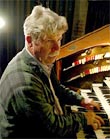|
|
 
|
|
Author
|
Topic: Surround Delay Time
|
|
|
|
|
|
|
|
|
|
|
|
|
|
|
|
|
|
|
Christos Mitsakis
Expert Film Handler

Posts: 242
From: Ag.Paraskevi, ATHENS, GREECE
Registered: Sep 1999
|
 posted 01-27-2003 08:55 AM
posted 01-27-2003 08:55 AM




Michael, next time you're here, make shure to be in touch.
Many open air theatres, especially in summer retreats are operating in an almost two months period. So for most of them it IS to much to invest in a full dolby sound system (even analog - Mark I agree with you but second hand market for older processors here is almost non existable). The movie rental prices of the distributors every year go up, and the audience is going "down". Consider, except in large cities, that all summer theatres are second run.
Most of them are still runing in mono, or plain 2 channel stereo, using DJ's mixers ![[puke]](graemlins/puke.gif) . In the best cases you can find home processors (I've seen Lexicon CP2 and CP3)with mixed results of sound quality. . In the best cases you can find home processors (I've seen Lexicon CP2 and CP3)with mixed results of sound quality.
Where I am involved I use a decent two to four channel mixer (like the soundcraft) always a preamp-processor (it gives me much flexibility) and if budget is very low, custom made, or used in good condition PA speakers. The results are excelent for the specific time and place. The extra high freq boost of the unprocessed SR is an asset. Sound becomes clear in VERY low volume settings. In most cases you have to turn down the volume in night hours so no complaints are made from the neibouring houses. I hate this but it is an unavoidable reality for open air theatres.
Christos.
| IP: Logged
|
|
Ray Derrick
Master Film Handler

Posts: 310
From: Sydney, Australia
Registered: Sep 2001
|
 posted 01-29-2003 03:32 AM
posted 01-29-2003 03:32 AM




It is not commonly realised that delay is used on the surround channel for TWO reasons. Firstly to 'synchronise' the screen and surround channels. This is because the surround speakers are much closer to the audience than the screen speakers, so audients will hear them much sooner. So the first objective is to delay the surround channel so that in the worst positions the room, (the rear corners) the surround sound does not preceed the screen sound. This technique is also commonly used in public address systems where additional speaker clusters may be placed say, half way down the auditorium. Without delaying these "rear" speakers, all the sound seems to come from these rear speakers rather than from the stage. It can be really annoying.
Secondly, for optical soundtracks, an extra 10 to 20 ms is added to that which is required for synchronisation, to make any front channel leakage into the surrounds less audible. (Haas Effect).
So in setting up the delay you should take at look at the rear corners of the theatre and determine which seats will have the biggest time difference between screen and surround and calculate the synchronisation delay for those seats, then add 10-20mS for optical formats. For digital, the extra 10-20mS is not necessary because of the high separation between channels.
Of course large auditoriums pose a special problem in that audients sitting towards the front may hear an echo from the surrounds. The best solution is to delay the front surrounds less than the rear, but since cinema processors don't provide multiple delays this must be achieved using external delay units. If that is outside the budget then you just have to reduce the delay and make the people up in the back corners really suffer!
Well after all, if you're prepared to pay out good money and then sit in the back corner of a cinema, you deserve to suffer! ![[Smile]](smile.gif)
| IP: Logged
|
|
|
|
|
|
|
|
All times are Central (GMT -6:00)
|
|
Powered by Infopop Corporation
UBB.classicTM
6.3.1.2
The Film-Tech Forums are designed for various members related to the cinema industry to express their opinions, viewpoints and testimonials on various products, services and events based upon speculation, personal knowledge and factual information through use, therefore all views represented here allow no liability upon the publishers of this web site and the owners of said views assume no liability for any ill will resulting from these postings. The posts made here are for educational as well as entertainment purposes and as such anyone viewing this portion of the website must accept these views as statements of the author of that opinion
and agrees to release the authors from any and all liability.
|

 Home
Home
 Products
Products
 Store
Store
 Forum
Forum
 Warehouse
Warehouse
 Contact Us
Contact Us




 Printer-friendly view of this topic
Printer-friendly view of this topic










![[thumbsup]](graemlins/thumbsup.gif) I have used my old Maranz AV500 in an open air cinema with great sucess. Auditorium length = almost 30m, time delay set to 70ms, Soundcraft spirit folio mixer for slit loss compensation and cell preamp. ...Where cost matters. Cinema owner got exellent comments from the patrons.
I have used my old Maranz AV500 in an open air cinema with great sucess. Auditorium length = almost 30m, time delay set to 70ms, Soundcraft spirit folio mixer for slit loss compensation and cell preamp. ...Where cost matters. Cinema owner got exellent comments from the patrons.
![[Wink]](wink.gif)
![[puke]](graemlins/puke.gif) . In the best cases you can find home processors (I've seen Lexicon CP2 and CP3)with mixed results of sound quality.
. In the best cases you can find home processors (I've seen Lexicon CP2 and CP3)with mixed results of sound quality.
![[Smile]](smile.gif)





